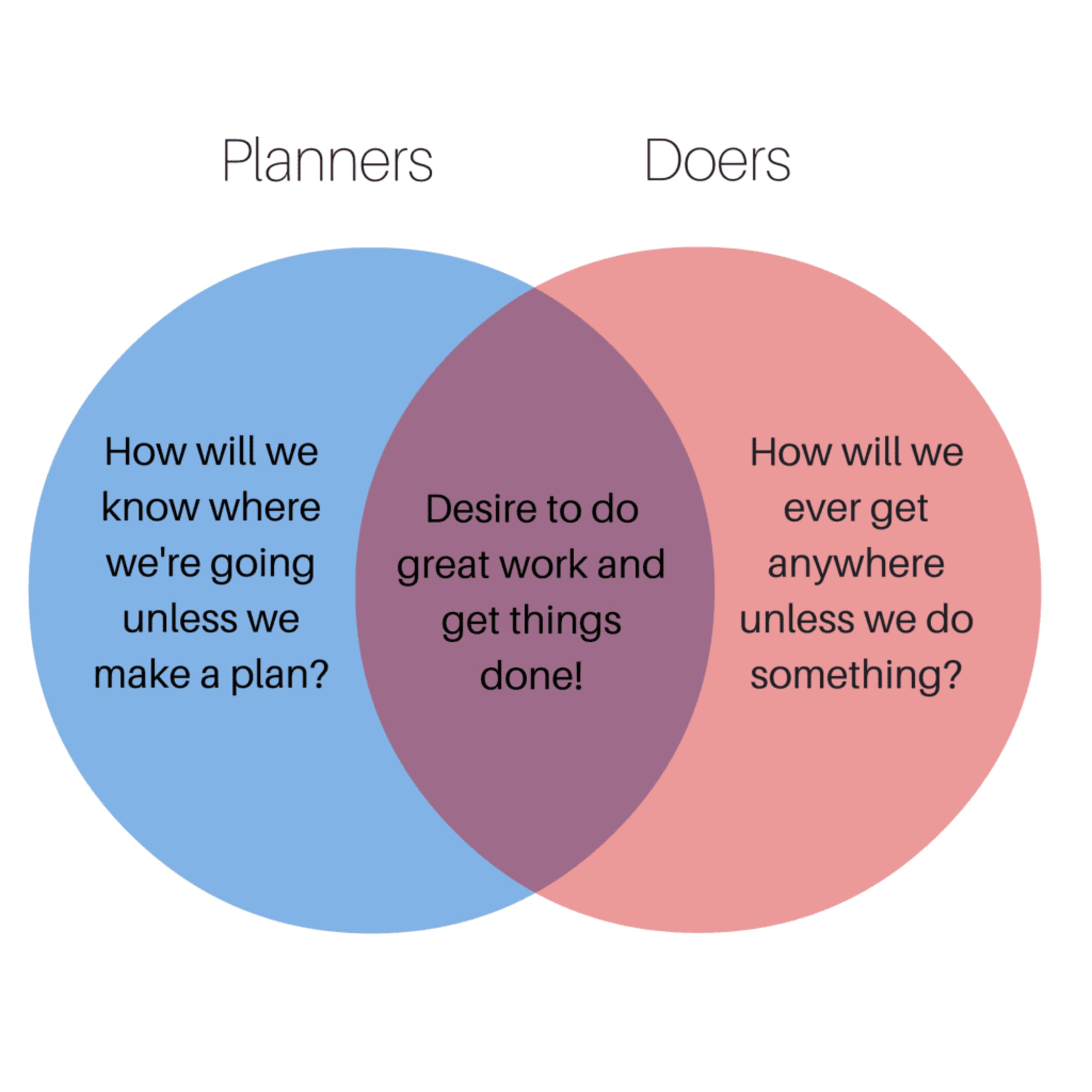“Do you consider yourself a planner or a doer?”
I paused at the question from a senior marketer at a software-as-a-service (SaaS) company where I was interviewing for a freelance position. “I’m a planner,” I replied honestly. “I like to make sure I know where we’re going and why we’re doing something before getting started.”
By the time we finished our call, I knew this was the wrong answer. The words “We’re doers here” came up at least two or three times.
Since making a career pivot into the startup and technology industry, I’ve come across this idea of “have a bias toward action” or “be a doer” countless times in descriptions of ideal traits for marketers. It’s always stuck out to me because I consider myself a planner. I map things out. I like to know exactly where I’m going.
I always thought that was a virtue. Clearly, it was a superior way to work compared to being a “ready, fire, aim” type who just did things without a plan? (The horror!) But as I’ve explored these ideas, it’s clear that, as with so many things, the ways we work are complex and we can all learn from each other.
Wondering which side of the divide you fall into? Just like in poker, a few key “tells” could give you away. Once you know which way you trend, learn how you can become a much more productive person by picking up a few habits from your opposite-workstyle teammates.
“F*ck it, ship it”: Why We Value Doers in Tech

I probably should have anticipated that questions like “Do you consider yourself a planner or a doer?” would come up in interviews more frequently in the startup world.
We’re all so focused on finding better ways of solving pains, why wouldn’t that desire for better engineering -- social, spatial, technological, emotional -- extend to the ways we work?
For a small team, the right talent and personality fit can be rocket fuel. Conversely, it would seem, adding someone who doesn’t work the way the rest of the team does could be cancerous. So I understand the caution and the emphasis on trying to find “people like us” to fill out the ranks of your team.
A lot of this attitude may come from needing to work against the ingrained way of doing things. There’s an urgency to espouse an anti-corporate, anti-bureaucratic, death-before-meetings type of thinking. In the same way messaging systems like Slack disrupt the staid status quo of email and meetings, startups and tech companies want to disrupt the traditional business model and ways of working.
Philosophies like “f*ck it, ship it” rose as a rallying cry and reminder to developers and hackers to stop spending ludicrous hours tweaking tiny details of every iteration. Just getting it out there can be both a path to more immediate feedback and an antidote to professional paralysis.
As LinkedIn founder Reid Hoffman famously said, “If you’re not embarrassed by the first version of your product, you’ve launched too late.”
In that capacity, I get it. We’re trying to fight stagnation by promoting action. We’re trying to promote innovation and “what’s next?” by putting ideas and solutions out into the community faster. We’re trying to get the team unstuck. We’re trying to work in iterations, because putting “final” on anything is begging for hilarious results like “final_final_FINAL_butseriouslyfinal.”
But what if other people with planner personality traits come across company philosophies that make them feel like planners need not apply? By focusing so heavily on action-oriented team members, are we losing an opportunity for more nuance in our teams and the way we work together?
The best teams work in a way that helps a variety of individuals and workstyles do their best. The first step to building productivity systems and workflows that work for you and your teams is to understand those styles.
The Planner

The stereotypical planner-type person is deliberate and thoughtful. Maybe a little bit introverted. An avid note-taker. Focused. This person thinks about ideas in terms of creating a relationship with another idea, either in a category, timeline or plan. This person may think in a relatively linear fashion, or at least prefer when things progress clearly in stages.
As part of a team, he or she might tend to be the ideas person or the organizer. The planner feels strongly that without a solid plan, the end product just can’t possibly be as good as it could be.
You might be a planner if…
- Project and task management software is like a real-world representation of how your brain works
- Outlines are your best friends -- and you think planning is part of the work, not the stuff you do before getting to the work
- The thought of “crossing that bridge when we get to it” gives you hives in any situation
- You tend to learn better by reading
- Starting a project without knowing your roadmap stresses you out
- You know nothing is ever done, but want to get as close to perfection as possible
Productivity-boosting traits:
- You tend to be prepared because you’ve spent time thinking through all the possibilities
- You rarely have to change directions mid-project because you failed to anticipate something
- Your scale-up time is reduced because you tend to think in terms of process
- You usually have the information you need because you organized it before you started
Ways this side of you could be holding you back:
- You feel like everything can be better and hesitate to let anyone else see it before it’s “ready”
- You might spend too long on everything
- You could adhere too closely to your plan, even when flexibility would help you or your team
- You might be too focused on tasks and timelines and not enough on product
- You could get stuck trying to work on anticipated barriers in a too-detailed plan, when in reality you have no idea how things will actually unfold once the development work starts
The Doer

The stereotypical doer-type person prioritizes action and energy. Maybe a little bit extroverted. If the doer likes the idea of something, he or she makes it happen. Barriers are made to be worked around, quickly and collaboratively. The doer might feel more comfortable with spontaneity and speed over process.
As part of a team, you might be the ideas person or one of the folks responsible for building the product. You feel strongly that a good idea is only good for a limited period of time, and teams should work fluidly and fast.
You might be a doer if…
- Making a detailed to-do list feels like taking time away from actually accomplishing those tasks
- Broad strokes goals are fine, but you don’t necessarily need to know where you’re going before you start
- You know that nothing is ever done, so why worry too much about perfection if the original idea is captured?
- The idea of meetings upon meetings before getting to work on an idea gives you hives
- You tend to learn as you go, and learn best by doing
Productivity-boosting traits:
- You work around barriers as they present themselves, instead of trying to think through every potential barrier before starting
- Your desire to get from idea to MVP as fast as possible gives you more time to gather feedback or tweak direction on an actual iteration (and this applies to “products” like blog posts too)
- You usually don’t get paralyzed by what’s next
- You’re adaptable because you can easily think outside the mental boxes created by outlines, progressions, categories and timelines
Ways this side of you could be holding you back:
- You might have difficulty adhering to deadlines, especially if you weren’t an active part of setting them up
- You could also have difficulty accurately estimating how long tasks will take
- You might have trouble replicating things you’ve done or delegating because you might not be very process-oriented
The Limitations of “Types”
We love to know ourselves. The popularity of personality tests like Myers-Briggs Type Indicator (MBTI) and the enneagram wheel shows that we’re desperate to understand why we do what we do. We want the ways we think and relate to the world to be an accepted “type,” to know that there are other people like us.
Get any group together, and it’s easy to see that people relate to the world in different ways, including the ways they work. Planning-oriented people and doing-oriented people do exist.
Of course, there’s no way to guarantee that understanding how you work means you can create the most productive version of yourself. And there’s no perfect way of putting people into buckets like “planner” and “doer.”
As happens when you try to apply a set of ideas to imaginary people, you end up with broadly drawn stereotypes. Planning-oriented people can develop a bias toward action. Many planning-oriented people already have the internal tools necessary to get out of an “analysis paralysis” rut.
You might be four parts one and three of the other, like the unicorn designer-who-codes. You could be an introverted doer, or an extroverted planner. Any type of person can have procrastination issues to overcome.
Still, I would argue that people tend to be more one way or the other when it comes to valuing plans or valuing action, even if that’s just a 55/45 split. Personality tests and categorizing people in broad terms might not be a perfect science or a good factor to weigh heavily in a hiring decision due to accuracy issues, but most of us can usually recognize pieces of ourselves in type descriptions.
We should prioritize diversity of experience and thought. I’m sure most of us would agree that the ideal team makeup includes both planners and doers. As long as everyone on the team is an ideas person and committed to the company mission, diversity in work types can breed an ideal work environment.
What a Planner Can Learn from a Doer

I once worked at a place where a business coach came in and gave us work personality tests in an attempt to smooth an occasionally troubled work environment. While it was incredibly interesting to see the different ways each person delivered information and moved ideas forward, it ultimately didn’t translate into a better way of working together because we didn’t act on that information.
I’ve worked with a lot of highly creative and talented people who ran the other direction when I approached with a Gantt chart or a task list. I’ve also worked with a lot of action-oriented people who appreciated a plan and worked hard to adapt their natures so we could work together comfortably in pursuit of our goals.
Planning-oriented people have a lot we can learn from our more action-oriented teammates and mentors. Especially in the tech and startup world, we need to be able to move with pace and learn to snap ourselves out of our own feedback loops.
What I’ve learned from doers over the years:
Perfectionism can paralyze
I’m a semi-reformed perfectionist, and I still have a complicated relationship with it. Of course we should all want to produce the highest quality. The problem lies in areas where there is no such thing as objective perfection.
I’ve learned from more action-oriented colleagues to retool the way I think about “perfect.” Quality means accuracy. It means, yes, take the time to spell things properly and make sure all of your guides line up and your button colors are 100 percent the same. Quality means your product or piece accomplishes your goal.
If you’re at the point where you’re satisfied with the accuracy and that your goal is accomplished, any time you spend over-tweaking now is just being selfish while chasing a mirage.
Just getting started saves a ton of time
This felt counterintuitive to me at first. How could starting without a complete plan save me time? But it can.
I recently developed a white paper for a client where we only had a solid plan for the first two or three sections, but only broad strokes for the rest. I had to gently push my planner-self to one side and let my nascent doer take over. Knocking out those first few sections helped crystallize the style and influence the direction of the later half, saving me tons of time over waiting for everything to be ready before starting.
You don't need to map out every step to know where you're going
As a former copy editor and project manager (and really, who is a “former” one of either of those things?), I embrace details with a fervor that can sometimes turn into a death grip.
If you’re a planner, understand that there are levels to planning. You don’t need to know who is going to set the reminder to update the syndication of that blog post’s automation just to start a blog post.
Start thinking about plans in terms of broader strokes. Was a goal clearly articulated? Does everyone understand that all tasks must take the team closer to this goal? Were milestones clearly outlined? Does each team member have the skills necessary to get to that milestone? Then take a deep breath, and try not to sweat the details to the point that you find it hard to get started.
Flexibility leads to more innovation
Plans are wonderful, wonderful things. But planner-oriented people can tend to idolize them too much.
Your plan isn’t carved in alabaster for eternity. Yes, your plan is there to prevent wild directional swings that could put the project at risk (funding and clients wait for no one’s flash of unrelated brilliance), but trying something different or encouraging creativity within the broad confines of the project can lead to amazing results.
Having a “bias toward action” still includes planning
This has been key for me as I try to nurture more “doer” tendencies in myself. Being a person with a bias toward action can mean keeping everything I value about planning and adding the ability to get out of my own way. I understand that this is the only way to move my ideas from just ideas into becoming reality.
What a Doer Can Learn from a Planner
Functioning as a team means utilizing everyone’s strengths. It can also mean borrowing other people’s superpowers to make your own workflow or productivity habits stronger. If you’re a more action-oriented person who can tend to be plan-averse, it might be useful to think about what you might learn from a teammate or mentor who’s coming at you with a Gantt chart or a task list.
You need a plan
I know, you already know I’m biased. But it’s true! You just flat-out need plans. Not overly complicated plans. Not bloated plans. But you need a roadmap.
Knowing the broad strokes of your goals, milestones and tasks can prevent wasting your time and effort on sideshows. It can also help you allocate resources and figure out when exactly you’re going to get this thing done.
Planning also benefits your entire team. Your teammates need a shared vision for where the project is going. Even if you’re solo, having a plan can help you remember your own goals for the project when you’re knee-deep in the weeds.
Structure can be useful
As a collaborative professional, you need to let people put you in a box sometimes, because off-the-walls creativity can sometimes create problems.
Consider a design team tasked with rebranding a prominent organization. There’s a phase for “any idea is a good idea” brainstorming. There’s a process for narrowing down ideas based on a rubric of what’s important to the client and getting them the best solution. There’s a process for winnowing all the way down to one idea. Everyone has had an opportunity to be their creative selves within the necessary confines of this process, otherwise it’s too easy to get stuck in the brainstorming phase.
Having a “bias toward action” still includes planning
Yes, I listed this one under “What a Planner Can Learn from a Doer,” but it works in reverse too. A doer who becomes laser-focused on action might get too used to flying by the seat of his or her pants with every task or project. That rarely works on teams, even teams oriented toward “ship before you think it’s ready.”
It’s worth remembering that leaning toward “do the thing” as our default setting still must include room for plans, even if they feel like constraints at first. Having a bias toward action means trying to work faster toward opportunities, not running in pursuit of every new trend, idea or shiny thing.
One Big, Happy, Productive Team

Of course, I’ve considered that at the core of it all, we just have a communication issue.
We all want to get things done, after all.
It’s entirely possible that planning-oriented people misinterpret “action-oriented” as “ready, fire, aim,” when it’s really meant to emphasize the importance of getting to a usable end product.
It’s entirely possible that action-oriented people misinterpret, “you need a plan” as “let’s form a committee and talk everything to death,” when it’s really meant to emphasize the importance of having a measurable roadmap to success.
With that in mind, the speed and iteration-focused language of “done is better than perfect” might feel more inclusive if teams made clear that the input of planning-oriented team members is also welcome. “We’re doers here,” might become, “we’re people who produce great work.”
Sometimes, language in company value statements can alienate people who actually do agree with the proposition and contribute to your team. The social scheduling company Buffer did a fascinating analysis of the effects of certain words, and how tweaking the way they communicated ideas changed their team dynamic for the better.
One of the things that drew me to tech and startups in the first place was the desire that drives us to solve problems and offer new paths forward. The status quo is a challenge. “Because that’s how it’s always been done” is rarely heard.
I like how all of us, planners and doers, push ourselves to do more, better, smarter, more efficiently. I understand how the offshoot of that can be an emphasis on just getting things done. But getting things done takes all kinds of people, and the ability to recognize our own growth potential in areas where we struggle.
I still think this post could use a little more work and could probably work on it forever, but guess what I said to myself after tinkering and tweaking for far too long? Learning from people who approach work differently from I do could be the biggest productivity hack I’ve ever used. Sometimes I just have to embrace my inner doer and ship it.

